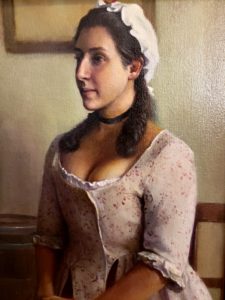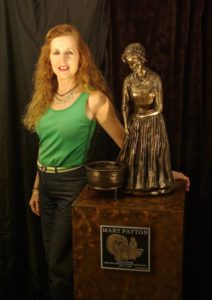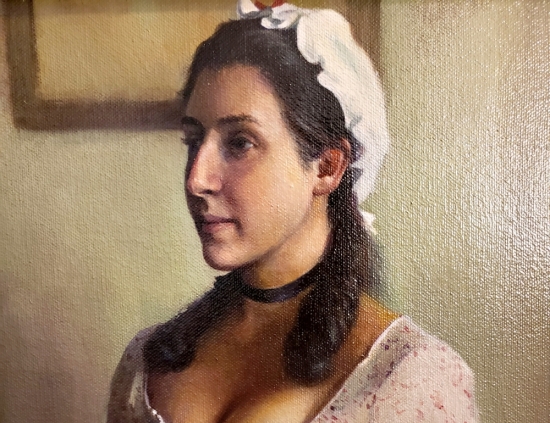
Mary McKeehan Patton was a gunpowder maker for the American Revolutionary War, in particular, the Battle of Kings Mountain in 1780. Several monuments exist in East Tennessee that honor the Battle of Kings Mountain. A Veterans Monument in Elizabethton, Tennessee, mentions Mary Patton on a side of its obelisk-shaped tower. Kings Mountain Monument in Kings Mountain National Military Park near Blacksburg, South Carolina, is a large obelisk tower commemorating the battle. Other markers are First Night Encampment by the DAR (Daughters of the American Revolution), near Roan Mountain, Tennessee; Overmountain Man monument at Sycamore Shoals State Park and Fort Watauga Monument are in Elizabethton, Tennessee.
Mary Patton was born in England in 1751 and arrived in Pennsylvania with her family. It is thought she learned the skill of powder making from her father, David McKeehan. She married John Patton in 1772. John served as a private in the Militia in Pennsylvania in the early American Revolution. The Pattons made gunpowder in Pennsylvania and later moved to the Overmountain region of North Carolina, now East Tennessee.
Andrew Taylor, a friend, helped them establish a mill nearby at what is known as Powder Branch. Mary Patton is famous for providing over five hundred pounds of gunpowder to the Overmountain Men for the Battle of Kings Mountain during the Revolutionary War. This battle is known to be the turning point in history that resulted in the defeat of Major Patrick Ferguson’s troops.
After the war, Mrs. Patton made and sold powder to many buyers. Gunpowder was made successfully due to Tennessee’s resources, such as caves to provide some of the ingredients needed. Gunpowder has three main ingredients: potassium nitrate or saltpeter, sulfur, and charcoal. Potassium nitrate was mined from caves in the area where Mary Patton lived.
Mary died in December 1836 and is buried at Patton-Simmons cemetery. She was known for the excellent quality of her powder. There are a few books written about her, and a DNA ancestry test has been made, which resulted in a portrait which may resemble her. I sculpted a bronze statue of her at work, stirring her kettle. It has been on display in two museums: Sycamore Shoals State Park in Elizabethton, TN, and Rocky Mount State Historic Site in Piney Flats, TN. Several of Mrs. Patton’s actual kettles are on permanent display at those facilities.

Mary Ruden is an artist with a focus on natural subjects such as orchids and butterflies, and joyful expressions such as music. Her influences come from her Welsh roots, and being in museums and gardens in Europe . . . She taught Adult Art and Design classes . . . for over eight years. She has created large outdoor sculpture for Public Art projects throughout the country using metal which is hand engraved or painted . . . Her work is in two State Parks in FL. She is active in the Knoxville Arts Alliance and shows art throughout the state of TN and nearby states.(Excerpted from the Mary Ruden Website. For more of her biography, click here.)
RESOURCES
Mary Patton: Powder Maker of the Revolution by Robert A. Howard and E. Alvin Gerhardt, Jr., 1980
“Mary McKeehan Patton”: TN Encyclopedia by Susan M. Goodsell.
**Featured image, possibly of Mary Patton, painted by Jeff Trexler, commissioned by Martin and Stormy Mongiello – from Find-a-Grave – CROPPED





I have serious doubts that the portrait is of the period of Mary’s youth or that the bust would have been painted in such a way.
Hello Mark. I’m so happy you found our magazine and enjoyed Mary Ruden’s article, which featured her amazing sculpture of Mary Patton. The portrait of Mary Patton’s possible likeness, was “painted by Jeff Trexler, commissioned by Martin and Stormy Mongiello,” who are Mary Patton’s descendants, according to The Greeneville Sun, article “MASSEY: Giving Thanks Every Day.” Trexler, based his painting on photographs Mary Patton’s descendants “to develop a composite to give an idea of what Mary Patton may have looked like in life.”
As to the dress she’s wearing in the painting, it is from the Colonial Period. During the time of the Revolutionary War, women’s low neckline/ bodice was the fashion of the period. About 20 years after the war, women were more prone to cover the neckline with linen or gauze scarfs or kerchiefs. The image can be found on Find-a-Grave, and in Betty Bean’s KnoxTNToday.com article “Gunpowder Mary: The (nearly) forgotten hero of Kings Mountain.”
Here are links to follow, should you wish:
https://www.maryruden.com/
https://www.dar.org/national-society/american-spirit-magazine/monument-magician-mary-ruden
https://www.greenevillesun.com/news/local_news/massey-giving-thanks-every-day/article_fad984d1-0e8f-50ca-96dc-a36ab9806942.html
https://www.americanrevolution.org/clothing/colonial7.php
https://www.findagrave.com/memorial/6053978/mary-patton
https://www.knoxtntoday.com/77961-2/
The composite is based on DNA, which is now able to suggest and generate an amazing likeness of people long gone.
It is not presented as an original, antique portrait as some comments might suggest.
I found the image fascinating as this is my fourth generation great grandmother on my father’s side.
I’m so very proud one of my ancestors inspired the artistic thought .
The piece is very well done.
I was also quite pleased with the article. I sincerely appreciate the effort and accuracy .
She was a legend.
I absolutely love it.
Thank you.
Sincerely,
Ilyse B
I am doing a project on Mary Patton and thank you guys for the information it has really helped me on my project cant thank y’all enough
I am the 9th removed granddaughter of gun powder Mary. John Patton and Mary Mckeenan. Samuel Clemmons Patton son of John and Mary. And so on… Joshua Morgan is my great great grand. Chester Bascomb Morgan great grand and Charles Fred Morgan is my grand pa. John Robert Morgan is my father McDowell County Marion. My father went to Black mountain elementary school.
I have a hard back family tree of the John Patton family.
Hi. I believe I am a descendent. My grandmother told stories about her family so that’s how I know who she was.
I am trying to get a copy of the book about Mary Patton. Do you have any information about that.
Rosi is my married name.
My Grandmother was Elizabeth Panell Goforth who grew up in Bakersfield NC
I am doing a project on Mary Patton and thank you guys for the information it has helped me alot .